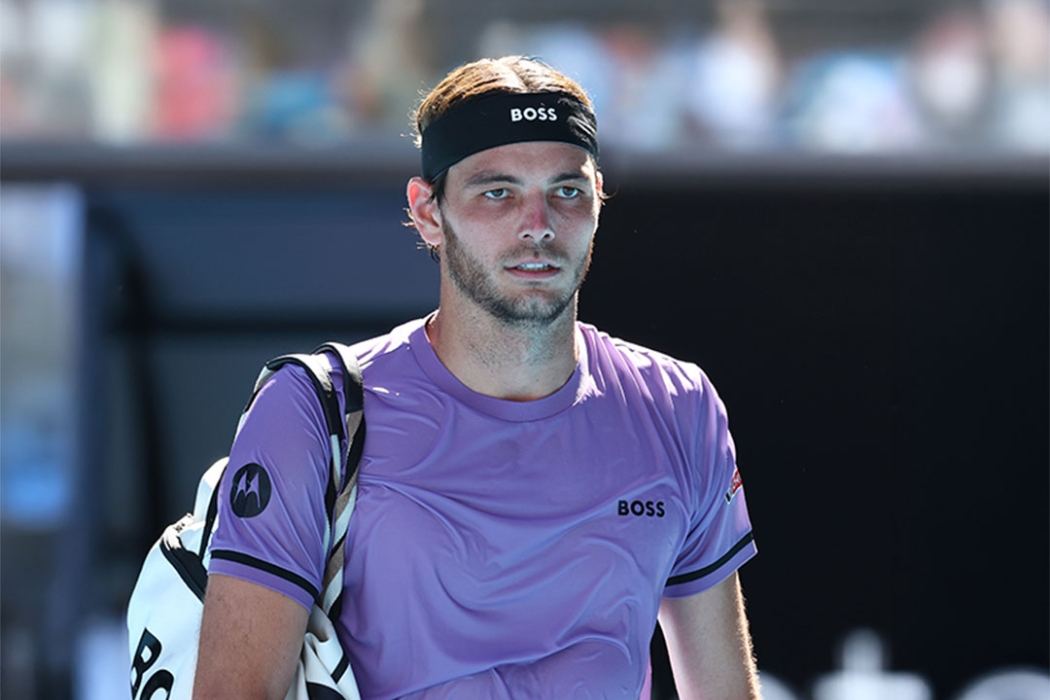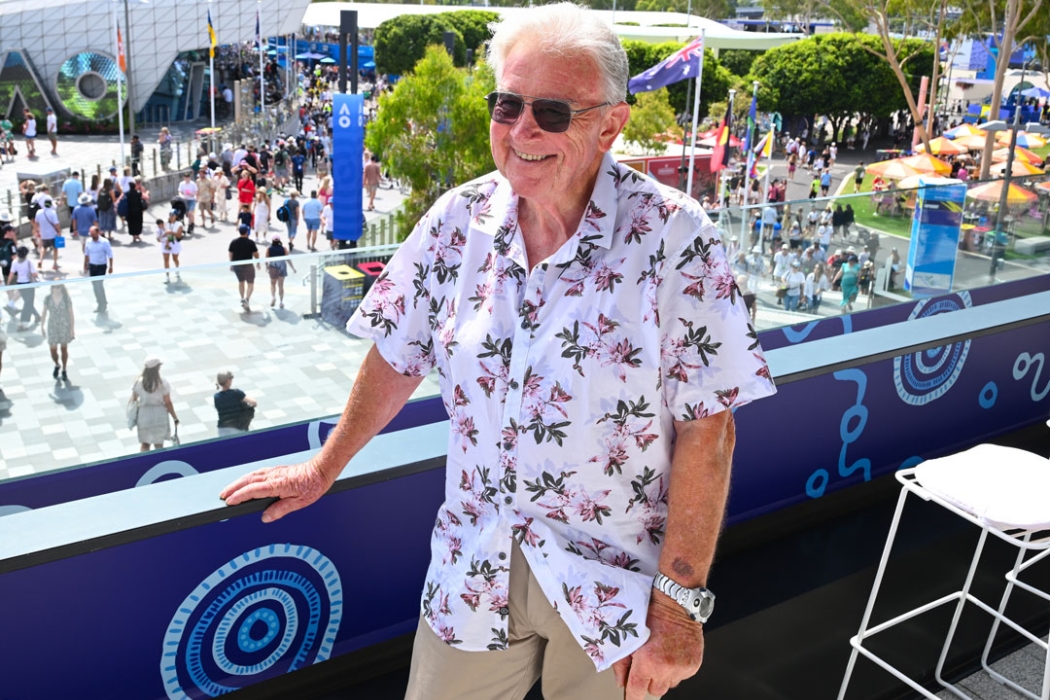The cool, dimly-lit network of tunnels underneath Rod Laver Arena are a contrast to the hot, bright sun and loud frivolity of the Australian Open outside.
Walking down a short staircase to a corridor on the perimeter is like transporting between worlds. A blue metal divider in the middle of a wide corridor forms two walkways – one for players, and one for all access staff. A sign designates which side to take.
The tunnel network allows players of AO 2025 to move around Melbourne Park exclusively underground. They don’t see the shops, bars, food stalls, hospitality tents, hydration stations, padel courts, ballpark, stages, musicians, big screens and fashionable outdoor furnishings that, outside of their matches, are the backdrop to a summer festival.
An overnight operations team works to reset, restock and refurbish the precinct daily. It takes five to six hours to move all the outdoor furniture back to its proper place alone.
The AO really is a 24/7 operation.

The players could be forgiven for not seeing any of Melbourne during the tournament. Everything they need, save for a bed to sleep in, is provided in one of the many rooms that span off the tunnels.
Kia-sponsored SUVs come and go into the belly of the beast, dropping players at two glass sliding doors that open into a large foyer where they arrive and leave from. Black and white signs fixed to the walls point to services available to them. There are beauty rooms where you can get a haircut, colour and styling.
“Some of them treat it like a blow-dry bar,” says one worker as she pens another booking into a large paper diary. And who can blame them? Arrive to work each day with locks as luscious as Kate Middleton’s? Yes, please and thank you.
There’s another space for waxing, facials, tinting, threading, a Mecca make-up station, plus a nail and brow bar. There’s a separate barber, which Novak Djokovic has apparently frequented. A coaches’ lounge, parents’ room, childcare, prize money office, seamstress and mental health provider. There’s no sense of urgency here as players and their entourages lounge on sofas and make enquiries at a concierge and practice desk.
We move further in, or is it out? I’m lost, though everyone else seems to know where they’re going. They move quietly, but with purpose.
The plush surrounds of the foyer that resembles a business hotel lobby give way to a hard lino floors and sharp fluorescent lighting. Players move between locker rooms and a recovery centre that smells strongly of Deep Heat. Someone makes a joke about the ice bath. There’s also a medical room housing various specialists.
Gyms and stretching areas are scattered around. TV grids affixed to walls show matches in progress, results, draws and weather forecasts.

A triangle on the floor forms a meeting point for the players as they, warmed-up, wait to be called to their court.
We move to a darkened tunnel that forms a T-intersection with the Walk of Champions. Coco Gauff glides past after her match at Rod Laver Arena. On a TV screen I see Carlos Alcaraz waiting in the triangle, waiting for her to pass, so he can walk on.
Everything is timed to the minute, with broadcasters and ticketholders in mind.
The Walk of Champions comprises a series of floor-to-ceiling LED screens, blue and white light from which illuminates the way to centre court. I wonder if the names and faces of past winners displayed on these screens is motivating or intimidating for the athletes as they make their way down. It’s a long walk, and the further you go, the hotter it gets. The air-conditioning is no match for the outside mercury at a certain point.

I poke my head in to take a peep of this champion corridor before I’m warned. “Step back. It’s all on TV.”
Moments later a cameraman and producer appear, manoeuvring backwards to capture Alcaraz as he does the walk. The athletic Spaniard glances quickly to his left at us in the other tunnel as he moves to a soundscape of commentators declaring past winners.
His match starts and back into the network we go, this time to a lift. It stops at four floors. The third level appears the most popular. Tennis bags loosely sit in open lockers, and on the floor, at the entrance to a large and open food court that has everything from lean protein to fresh coconut water, fruit, pizzas and burgers.
One more level up, an outdoor rooftop overlooks the precinct where the bustling crowd below resembles a moving rugby maul.
Director of Precinct Operations and Logistics Emma Hopkins is one of the women in charge of making sure AO 2025 runs smoothly. She’s a bit like the White Rabbit, keeping one eye on the time as we speak.
“Our event has grown considerably over the last five years and we now run a 24/7 operation in order to be prepared for the next wave of patrons coming through our gates,” she says.
“We have over 100 trucks and deliveries coming into the precinct overnight every night, including catering and service deliveries as well as cleaning, waste and maintenance vehicles.”
The daytime operations crew clocks on as early as 5am. Meetings punctuate the morning before gates open at 9.45am. In the afternoon it’s about managing the finish of afternoon matches with the beginning of night sessions.
“One of our biggest challenges with tennis is that there is no set end time. So even though tonight's play is planned to commence at 7'o’clock, it's very much dependent on when the afternoon session finishes,” she says.
“We keep a close eye on match progression and the changeover from the afternoon session into the evening's match play commencing is planned down to the minute.
“Once we hit a particular time, we know that we are not going to be able to change over the venue in time. We need to get day sessions egressed out of the arena, we then clean the arena bowl and open the doors for the evening session patrons to find their seats.”
Overnight operations commence from 11pm, when the overnight manager takes over and leads a crew of team members with a long list of tasks to complete before the sun comes up.
Hopkins compares them to magical fairies that the public and players never see, working unseen to make the precinct brand new on the daily.
“Overnight tasks include things like F&B deliveries, waste collection, restocking of kitchens, fridges, water and gas. Our logistics team work through the night to reset all the furniture across the precinct prior to gates opening the next day. There is also a mammoth amount of cleaning to be done in the wee hours of the morning to ensure the venue is presentable for the next day.”
Game, set, match isn’t even half of it.
Timeline: A day in the life of AO 2025
5am: The day kicks off with the logistics crew working their magic across the precinct to complete all the overnight tasks prior to vehicle restrictions at 8am.
6am: The Venue Communication Centre (VCC) is stood up ahead of the day's operations commencing. The VCC is the main hub of the precinct that runs the site and includes representatives from Tennis Australia, Victoria Police, Melbourne and Olympic Park, St John Ambulance Victora and Fire Rescue Victoria.
The VCC facilitates access across the site for vehicles, deliveries, rectification works that need to happen. They’ve got until 8am every morning to do any works, deliveries, cleaning, set-up.
8am: Deadline for vehicles and delivery staff to leave site. Merchandise teams will be restocking across their shops using trolleys. Every morning, an event briefing is held for all stakeholders, which includes an overview of the day as well as key activities and operational timings that everyone needs to know. Zone managers and supervisors will then brief their respective teams to ensure everyone is set up for the day ahead.
9.30am: All teams are briefed and into position to open gates.
9.45am: Gates open for all ticketed patrons and the focus turns to match-call for players. Match call involves the players being called for the first matches of the day. They will meet in a particular location to be escorted to the court for their match.
11.00am: Matches start across the precinct and the VCC will monitor the site and respond accordingly to any situation or incidents that may arise.
3.00pm: Afternoon briefings prior to shift changeover to the night session. At the time, the team will review how the day is flowing, discuss any critical issues and run through the operations for the evening session.
4.45pm: Gates for night session open. VCC monitoring play and determining whether there will be a late changeover between the afternoon and first night match scheduled to start at 7pm. The main arenas must be emptied of day patrons and cleaned before night patrons are allowed in. It’s a really challenging time on-site because there’s a double-up of patrons, all day and night patrons, and sometimes you can have all three arenas in changeover.
7.00pm: Night matches start, if there is no late changeover.
11.00pm: Overnight Operation starts and the night team will participate in a briefing to ensure everyone is across the works and tasks to be completed that night.
Midnight-3.00am: All patrons and players leave Melbourne Park. The security team will do a sweep of the site to ensure there are no remaining players or patrons. Once the 'all clear' call is given, overnight works can commence.
1.00am-8.00am: This is the delivery and works window to refresh and preset for the next day's event.

